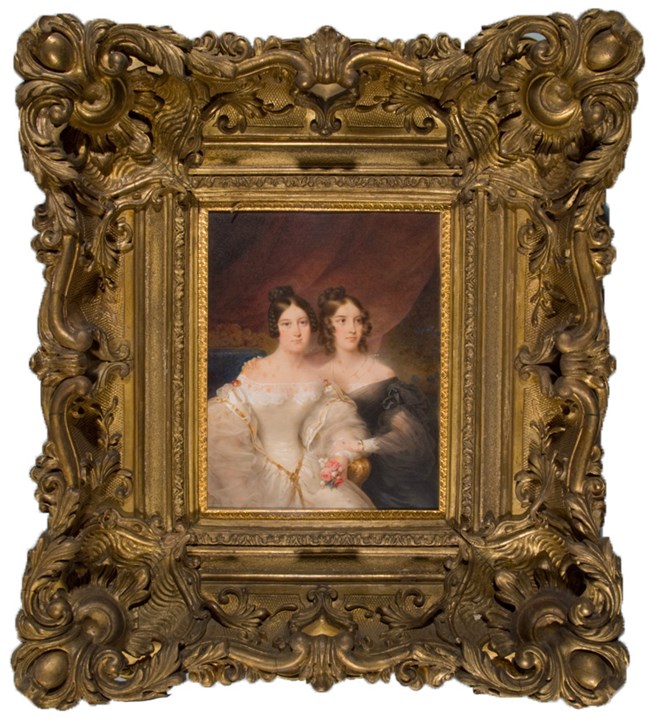Last updated: August 6, 2021
Article
Souvenirs of the Grand Tour
In the mid-19th century, members of the Longfellow family followed in the footsteps of well-off young men taking a Grand Tour across continental Europe to absorb the culture of France and Italy. Many of their collected souvenirs decorate the Longfellow House today.

Museum Collection, Longfellow House-Washington's Headquarters NHS (LONG 36014)
1826: Studying Abroad
In 1826, Henry Wadsworth Longfellow crossed the Atlantic Ocean to study in Europe to prepare for a position teaching modern languages at Bowdoin College. The objects in the Longfellow House today from this trip are largely books, indicating his academic focus on his first European travels. He studied instructional books on French and German grammar and collected poetry and prose works in several languages, including Comedias de Don Pedro Calderon de la Barca, Bezauberte Rose, Romantische Gedicht in Drei Gesangen, and Antologia Italiana.
In Rome, Longfellow received a gift of three pocket volumes of Dante’s Divine Comedy from a new friend, George Washington Greene. Both Dante and Greene would go on to be lifelong companions.

Mary and Fanny Appleton by Jean Baptiste Isabey, 1836-7
Museum Collection, Longfellow House-Washington's Headquarters NHS (LONG 4152)
1835: Appletons Hunting "Lions"
Fanny Appleton was unusually privileged to have the benefit of a Grand Tour. Her large party – her father, brother and sister, and two cousins – sought in Europe a cultural education, business connections, and better health for the consumptive William Appleton. As they travelled through major cities, they visited the tourist highlights of art and architecture, which Fanny referred to as "'lion'-hunting." The wealthy Appleton family’s souvenirs included commissioned portraits in Paris and Florence – the miniature of Fanny and Mary Appleton by Isabey hung in the Louvre before returning to Boston, and now hangs in the Longfellows’ dining room.
Appleton’s most personal souvenirs were the records she kept of her trip in six journal volumes and two sketchbooks. As her family saw the important tourist sites of England, France, Italy, and Switzerland, she eagerly soaked up the art and landscapes she encountered, recording the highlights with her pen and pencil.

Museum Collection, Longfellow House-Washington's Headquarters NHS (LONG 4635)
1835: "many months in lonely wandering"
In 1835, Henry Longfellow returned to Europe for a second time, to acquire more languages in preparation for a new professorship at Harvard College. Rather than travelling solo, as he had on his first trip, Longfellow now served as the escort for his new wife, Mary, and two of her friends. He again collected foreign literature, both for his library and that of Harvard. He also acquired more decorative souvenirs, including the statuette of the German poet Goethe which stands above the desk in Longfellow’s study today.
These two years abroad were transformative in Henry Longfellow's life, marked by the death of his wife Mary Longfellow and his first introduction to Fanny Appleton. Seven years later, on the occasion of their wedding, Fanny presented Henry with her sketchbook, as a souvenir of their meeting in Switzerland.

Longfellow Family Photograph Collection, Longfellow House-Washington's Headquarters NHS (3007.002/002.004-#041)
1868: "splendors of the great towns across the sea"
In 1868, Henry Longfellow embarked on his grandest Grand Tour. He crossed the ocean at the head of a party of eleven family members – his five children, new daughter-in-law, brother, two sisters, and brother-in-law. An international celebrity, he needed no letters of introduction; he received honorary degrees, an audience with Queen Victoria, and was hosted by Europeans and American expatriates. Souvenirs from this trip decorate the house today – the copy of “Cardinal Walking by the Fountain” above the dining room fireplace, the commissioned portrait of Franz Liszt by G.P.A. Healy in the library, and the small oil painting of “The Departure of Hiawatha” by Bierstadt were all collected on this trip.
Thomas Gold Appleton, Longfellow's brother-in-law, sought out souvenirs on this trip with en eye toward building Boston's cultural institutions. In March 1869, he purchased 38 Greek vases from Alessandro Castellani in Naples, which he donated in 1876 to the Museum of Fine Arts in Boston.
Five months after the family’s return to Cambridge, Henry Longfellow felt overwhelmed by the volume of “books and pictures” they had acquired, lamenting, “Where shall I find room for them all? I really do not know.” He did find room, and these treasures fill the house today, tangible reminders of the Grand Tour’s lasting impact on the Longfellows.
